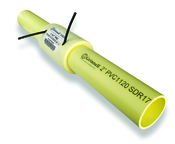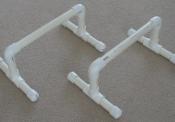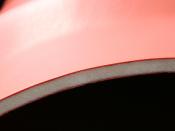Title: Conservation of Energy Lab
Purpose: To verify that the total energy of an object doesn't change if the object hasn't done work.
Procedure:
1. Attach a photo gate to the bottom of the tube that is attached to a vertical metal rod.
2. Attach the photo gate to the computer, and open Mac Motion.
3. Record all measurements, tube to ground, tube to photo gate.
4. Go get a small piece of PVC pipe that will be dropped through the tube
5. Measure both mass and length of the small piece of PVC pipe.
6. Drop the small piece of PVC pipe through the long piece of pipe and through the photo gate
7. Record the amount of time it took for the small piece of PVC pipe to pass by the photo gate.
Data:
pg = photo gate
Small piece of PVC pipe mass: .0116kg
Small piece of PVC pipe length: .058m
Length from the top of the tube to the ground = 1.867m
Distance from the photo gate to the ground. = .266 m
Trial #Time for the object to pass through the (pg)
1.0115s
2.0116s
3.0118s
Calculations:
TE = Total Energy
PE = Potential Energy
KE = Kinetic Energy
m = mass
g = gravity = 9.81N/kg
h = height
Calculating the TE of the small piece of PVC pipe at the top of the tube before we dropped it.
PE=mgh=(.0116kg)(9.81N/kg)(1.876m)=0.212J
KE=1/2mv"=0J
TE=PE+KE=0.212J+0J=0.212J
Calculating the Average Speed of the object as it passes through the photo gate.
.0115s+.0116s+.0118s
------------------------------- = .0116s
3
.058m/.0116s
------------------- = 5m/s
.0116
Calculating the TE of the small piece of PVC pipe as it passes through the photo gate.
PE=mgh=(.0116kg)(9.81N/kg)(.266m)=0.030J
KE=1/2mv"=1/2(.0116kg)(5m/s)"=0.145J
TE=PE+KE=0.175J
Calculating the difference in TE between the top of the tube and the photo gate
.212J-.175J=.037J
.175J
-------- = 83%
.212J
100%-83%=17%
This shows that we incurred a loss of 17% of the TE between the drop of the small piece of PVC pipe and it passing through the photo gate.
Conclusions/Sources of Error
We found that the experiment was not perfect but the formula does seem to be accurate. Our groups experiment showed a 17% loss in energy between our original total energy calculation at the top of the tube and our total energy calculation as the object passed through the photo gate. This loss in energy can be accounted for by friction between the small piece of PVC pipe and the inner wall of the large pipe, as well as the impact of air molecules on the small piece of PVC pipe.
Sources of error for this experiment mostly come in the form of setup; if our large PVC pipe was at a small angle it would have increased friction and decreased the total energy of the small piece of PVC pipe as it passed through the photo gate.


